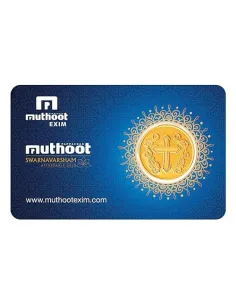Exclusive Deals & Trending Items


Muthoot Pappachan Swarnavarsham Gold BIS Hallmarked Ganesh Pendant of 5 gms in 22 KT 916 Purity Fineness
Shop Now

MMTC-PAMP 50gm Laxmi Ganesh Shankh Silver Coloured Coins of 25 Gram Laxmiji and 25 Gram Ganeshji in 999.9 Purity / Fineness
Shop Now

Muthoot Pappachan Swarnavarsham Gold Hallmarked Cross Coin of 5 gms in 22 KT 916 Purity Fineness
Shop NowWhen you think about adding to your investment portfolio, precious metals are a common choice. You might be thinking about whether to pick gold or platinum. Both offer unique benefits and can strengthen your portfolio.
Gold is often viewed as a safe investment. Platinum, on the other hand, is used in many industries, like cars. Knowing when to choose gold vs. platinum is key to smart portfolio decisions.
Key Takeaways
- Both gold and platinum can be valuable additions to a diversified portfolio.
- Understanding the unique benefits of each metal is key to making informed investment decisions.
- Consider your investment goals and risk tolerance when choosing between gold and platinum.
- Platinum investments can offer a hedge against inflation and market volatility.
- Research and analysis are crucial to making the best investment opportunities.
The Allure of Precious Metals in Investment Portfolios
Precious metals have a long history and are still valuable today. They offer a mix of stability and growth potential. This makes them a great choice for diversifying your investments.
Historical Significance of Precious Metals as Stores of Value
Gold and platinum have been valued for centuries. They are rare and last long, making them a safe choice for wealth protection. These metals have kept their value, making them a key part of investment portfolios.
| Metal | Historical Use | Modern Investment Appeal |
|---|---|---|
| Gold | Used in coins and jewelry | Hedge against inflation and currency devaluation |
| Platinum | Industrial applications and jewelry | Diversification and potential for high returns |
Why Modern Investors Turn to Precious Metals
Investors seek precious metals in uncertain times. They want to protect their money from market ups and downs. With the world facing economic challenges, they look for top financial planning and diversified investment portfolios. Precious metals offer a solid asset during shaky markets.


Adding precious metals to your strategy can lower risk and boost returns. They are key in a investment diversification plan. This helps achieve long-term financial goals.
Understanding Gold as an Investment Asset
Gold is a key part of investment plans, known for its value, security, and long-term wealth growth. For investors in India and globally, knowing how gold works is key. It helps in making smart investment choices.
Gold’s Historical Performance and Price Trends
Gold has always been a safe value, with its price changing due to many factors. These include economic signs, world tensions, and currency changes. Gold often does well when the economy is shaky, acting as a hedge against market volatility. Over time, gold’s price usually goes up, but it can swing.
Physical Properties and Industrial Applications
Gold is valuable not just for money, but for its special physical traits. It’s very flexible, good at conducting electricity, and doesn’t rust easily. These qualities make gold vital in fields like electronics, dentistry, and space. Demand from these areas helps keep gold’s value and price steady.


Cultural Significance of Gold in India
In India, gold is more than just an investment. It’s a sign of wealth, luck, and family prosperity.
Gold in Indian Weddings and Celebrations
Gold is big in Indian weddings and celebrations. It’s given as gifts to celebrate big moments. This tradition boosts gold demand and shows its value in Indian culture.
Gold as Family Wealth Transfer
Gold is also a way to pass wealth to future generations in families. It’s seen as a reliable asset that can be handed down, offering a real value for the next generation.
Knowing about gold’s history, uses, and cultural role is vital for investors. Whether for its past performance, industrial uses, or cultural importance, gold is a key part of a well-rounded investment portfolio.
Platinum Investments: Opportunities and Considerations
Platinum is rare and valuable, making it a great choice for those looking for high-yield investments. It’s not just a treasure to hold; it’s also used in many industries. This makes it a smart pick for adding variety to your portfolio.
Platinum’s Unique Properties and Rarity
Platinum is rarer than gold and has special qualities. It’s dense and melts at high temperatures, perfect for things like car parts and jewelry. Its scarcity and many uses make it a secure investment option.
Industrial Demand and Applications
Platinum is in high demand, especially in cars for its role in catalytic converters. It’s also used in jewelry, gadgets, and medical tools. This wide use helps keep its value steady and its price stable.
Historical Price Performance of Platinum
Platinum’s price has swung more than gold’s, due to changes in demand and supply. Yet, it has seen big price hikes, drawing in investors seeking long-term growth. Knowing its past price trends and what affects it is key for smart investing.
Gold vs. Platinum: Comparative Market Analysis
Looking at gold and platinum can help investors diversify their portfolios. It’s important to understand the market dynamics of these metals.
Price Volatility Comparison
Gold and platinum both have price volatility. This is due to many factors like economic indicators and geopolitical events. But, their volatility patterns are different.
Gold is often seen as a safe asset. Its price is influenced by currency changes and investor feelings. Platinum, however, is more tied to industrial demand, especially from cars.
Gold has been less volatile than platinum in the past. But, recent trends show a change. Knowing these patterns helps investors make better choices.
Supply and Demand Dynamics
The supply and demand of gold and platinum affect their prices. It’s key to understand these dynamics to predict price changes.
Mining Production Factors
Mining production is crucial for both gold and platinum. Issues like mining costs and geopolitical problems in major countries can change the global supply.
Recycling Impact on Supply
Recycling also affects the supply of these metals. Gold has a bigger recycling market because it’s more used in investments and jewelry. Platinum, while recyclable, has a smaller market due to its less common use in jewelry and investments.
| Metal | Primary Supply Sources | Recycling Rate |
|---|---|---|
| Gold | Mining (75%), Recycling (25%) | 30% |
| Platinum | Mining (80%), Recycling (20%) | 20% |
When thinking about investing in gold or platinum, it’s crucial to understand these market dynamics. By looking at price volatility and supply-demand, you can make choices that fit your investment goals and risk level.
Investment Vehicles for Gold and Platinum in India
Investors in India can diversify their portfolios by investing in gold and platinum. The Indian market offers a range of investment options. These options cater to different investor preferences and risk appetites.
Physical Ownership Options
Physical ownership of gold and platinum is a popular choice among Indian investors. This can be in the form of jewelry, coins, or bars. When investing in physical gold or platinum, it’s essential to consider the purity and authenticity of the metal.
Jewelry vs. Coins and Bars
Jewelry is a traditional and culturally significant form of gold investment in India. However, coins and bars are often preferred for their purity and ease of storage. Coins and bars are also more liquid than jewelry, making them a popular choice for investors.
Hallmarking and Purity Standards in India
In India, hallmarking is a crucial aspect of ensuring the purity of gold jewelry. The Bureau of Indian Standards (BIS) is responsible for hallmarking gold jewelry. This ensures that it meets the required purity standards.
ETFs and Mutual Funds Available to Indian Investors
Exchange-Traded Funds (ETFs) and mutual funds are popular investment options for gold and platinum. These financial instruments allow investors to invest in precious metals without the need for physical ownership. ETFs and mutual funds offer a convenient and cost-effective way to diversify portfolios.
Some of the popular gold ETFs in India include Gold ETF schemes offered by various asset management companies. These ETFs track the price of gold and provide investors with exposure to the metal.
Sovereign Gold Bonds and Digital Gold Platforms
Sovereign Gold Bonds (SGBs) are another investment option available to Indian investors. SGBs are issued by the government and offer a secure and tax-efficient way to invest in gold. Digital gold platforms also provide investors with a convenient way to invest in gold, with the added benefit of storage and security.
When choosing an investment vehicle, investors should consider their investment goals, risk tolerance, and time horizon. It’s essential to evaluate the pros and cons of each option before making a decision.
Risk Assessment: Gold vs. Platinum
When you explore gold and platinum investments, knowing the risks is key. Both metals have different risks that can change your investment’s value. It’s important to understand these risks to make smart choices.
Market Risks and Price Volatility
Gold and platinum face market risks and price changes. These changes are due to economic issues, world events, and how much is available versus what’s needed. These price swings can greatly impact your investment’s worth. For example, when the economy is shaky, gold prices might go up. But platinum prices can change a lot because of how much it’s used in industry.
Liquidity Considerations in the Indian Market
Liquidity is also a big deal when investing in gold and platinum. In India, gold is usually easier to sell than platinum because of its cultural importance and high demand. But, both can be sold fairly quickly, depending on the market.
| Investment | Liquidity | Volatility |
|---|---|---|
| Gold | High | Moderate |
| Platinum | Moderate | High |
Storage and Security Challenges
Having gold and platinum means you need to store them safely. This can be tricky and costly. You can store them in bank lockers, home safes, or specialized facilities. Each option has its own price and security level.
Knowing the risks of gold and platinum investments helps you manage your portfolio better. Good risk management is essential for investing in precious metals successfully.
Diversification Benefits of Precious Metals
Adding precious metals to your investment portfolio can boost long-term wealth. Gold and platinum can make your portfolio more balanced. This balance helps protect against market ups and downs.
Correlation with Traditional Asset Classes
Precious metals often move differently than stocks and bonds. This makes them great for a diversified portfolio. When stocks and bonds fall, precious metals can help reduce losses.
Correlation Coefficients:
| Asset Class | Correlation with Gold | Correlation with Platinum |
|---|---|---|
| Stocks | 0.02 | 0.15 |
| Bonds | -0.05 | 0.08 |
Portfolio Allocation Strategies for Indian Investors
Indian investors should consider precious metals in their portfolios. The right amount depends on your goals, risk level, and how long you plan to invest. A common range is 5% to 15% of your total portfolio.
Think about your investment goals and how much risk you can take when choosing your allocation.
Tax Implications for Precious Metal Investments in India
Investing in gold and platinum in India comes with many tax rules. It’s important to know these rules to make smart choices and cut down on taxes.
Gold Taxation Policies
Gold investments in India face different tax rules. You should understand the taxes on physical gold, gold ETFs, and other options.
Capital Gains Tax on Physical Gold
Physical gold is seen as a capital asset. Selling it means you’ll face capital gains tax. The tax rate changes based on how long you held the gold, with longer periods getting lower rates.
Tax Treatment of Gold ETFs and Funds
Gold ETFs and funds are seen as securities. Their gains are taxed as capital gains. The tax rate depends on how long you held them, so think about taxes before investing.
Platinum Taxation Considerations
Platinum investments in India also have tax rules. It’s key to know how platinum is taxed and how it compares to gold.
| Investment | Tax Treatment |
|---|---|
| Physical Gold | Capital Gains Tax |
| Gold ETFs | Capital Gains Tax |
| Platinum | Similar to Gold |
Strategic Tax Planning for Metal Investments
To lower your taxes, plan your metal investments wisely. This means knowing the tax rules for each option and making smart choices.
Knowing the tax rules for gold and platinum in India helps you make better choices. It’s crucial to understand the tax policies and plan your investments carefully.
The Indian Market Context for Gold and Platinum
India’s market for precious metals is changing. This is due to new consumer preferences and rules. Knowing this market well is key for smart investing.
Cultural and Traditional Factors Influencing Gold Demand
Gold is deeply rooted in Indian culture, especially in jewelry. Demand for gold is high because of cultural events like weddings and festivals. Expert financial advisory firms say gold’s cultural value drives its demand in India.
Growing Platinum Market in India
The platinum market in India is expanding. This is because of growing awareness and demand from car and jewelry industries. Market trends show more people are investing in platinum. This is also because platinum is used in car parts.
“The growing awareness about platinum and its various applications is expected to drive its demand in the Indian market.” – A leading expert financial advisory firm.
Regulatory Environment and Government Policies
Rules and government policies shape the gold and platinum markets in India. New plans, like Gold Monetization Schemes, aim to use more domestic gold and cut imports.
Gold Monetization Schemes
The Gold Monetization Scheme lets people and groups put gold in banks. They earn interest on it. This scheme aims to use gold that’s not being used and lower gold imports.
Import Duties and Regulations
| Regulation | Description | Impact |
|---|---|---|
| Import Duties | Taxes on imported gold and platinum | Increases cost for investors |
| Regulatory Compliance | Adherence to government regulations | Ensures market stability |
It’s important for investors to understand these factors in the Indian market. By keeping up with market trends and rule changes, investors can make better choices about gold and platinum.
Long-Term Investment Outlook for Gold and Platinum
The future of gold and platinum investments is shaped by many factors. As an investor, it’s important to understand these to make smart choices. We’ll look at economic trends, new technologies, and expert predictions that will influence gold and platinum’s value.
Macroeconomic Factors Affecting Precious Metals
Things like inflation, interest rates, and currency changes affect gold and platinum prices. When the economy is shaky, people often buy these metals as a safe choice. For example, gold usually does well when inflation is high because it protects against losing buying power.
The value of the US dollar also matters. A strong dollar makes these metals pricier for investors with other currencies. Knowing these economic factors helps you make better investment choices.
Technological Developments Impacting Demand
New technologies are changing how much people want gold and platinum. For instance, more electric cars mean more demand for platinum, used in car parts. Keeping up with these tech changes helps you see how they might affect metal demand.
Expert Forecasts and Projections for the Indian Market
Experts say India will be key in the global demand for gold and platinum. As India’s economy grows, so will the need for these metals. Understanding these forecasts helps you make better investment plans.
Some experts think India’s growing middle class will boost demand for these metals. This is because more people have money to spend on luxury items. By looking at these predictions, you can plan your investments for the long term.
Creating a Balanced Precious Metals Strategy
Investing in gold and platinum wisely can reduce risks and boost potential gains. It’s key to have a solid strategy for precious metals to meet your investment goals.
Determining Your Investment Goals and Timeline
First, set clear investment goals and a timeline. Are you looking for long-term growth or short-term security? Your goals will shape your investment choices.
Consider your financial situation, how much risk you can take, and your investment time frame. Precious metals can protect against inflation, currency changes, and market ups and downs.
Allocation Percentages Based on Risk Tolerance
Your risk tolerance affects how much of your portfolio to put in precious metals. A general guideline is 5% to 15%. But, this can change based on your risk level and financial aims.
| Risk Tolerance | Allocation Percentage |
|---|---|
| Conservative | 5%-10% |
| Moderate | 10%-12% |
| Aggressive | 12%-15% |
Rebalancing and Monitoring Your Metal Investments
Regularly rebalancing your portfolio is crucial. Market changes can alter your precious metal investments’ value. You might need to adjust to stay on track with your strategy.
“The key to successful investing is not about timing the market, but rather time in the market.” –
Keeping a close eye on your investments helps you react to market shifts. It’s also a chance to rebalance your portfolio. This ensures it matches your investment goals and risk level.
Common Mistakes to Avoid When Investing in Gold and Platinum
To make sure your investment in gold and platinum is safe, avoid common mistakes. These mistakes can cause you to lose money. Knowing what to watch out for is key to making smart choices.
Timing the Market
Trying to guess when gold and platinum prices will go up or down is a big mistake. Even experts can’t always get it right. Instead, think about investing for the long haul. Focus on how these metals perform over time.
Overlooking Storage and Insurance Costs
Don’t forget about the costs of keeping your gold and platinum safe. You might need to rent a safe or buy insurance. These costs add up. Make sure to include them in your plans to avoid surprises.
Ignoring Authentication and Purity Standards
Make sure your gold and platinum are real and of high quality. Check for hallmarks or stamps that show their purity. Be careful of fake products. Always check the seller’s credentials before buying.
Avoiding these mistakes can help you make better choices and get better returns. Getting advice from a financial expert can also help. They can guide you on the best way to invest in gold and platinum.
| Common Mistakes | Consequences |
|---|---|
| Timing the Market | Potential losses due to market volatility |
| Overlooking Storage and Insurance Costs | Additional expenses and potential losses |
| Ignoring Authentication and Purity Standards | Risk of purchasing counterfeit or low-quality products |
Conclusion: Selecting the Right Precious Metal for Your Investment Goals
When you’re looking into precious metal investments, you have to decide between gold and platinum. This choice depends on your financial goals and how much risk you’re willing to take. Your investment goals, how long you plan to hold onto your investment, and your knowledge of the market are all important.
Gold and platinum each have their own benefits. Gold is often seen as a safe investment. Platinum, on the other hand, is linked to industrial demand. When looking at platinum, think about its rarity, its uses in industry, and how its price can change.
Before making a choice, think about how your investment fits into your overall portfolio. Also, remember the taxes you’ll have to pay on your investment. A balanced approach to precious metals can help you take advantage of market chances while keeping your risk low.
In the end, picking the right precious metal is about matching your investment with your financial goals. By understanding what gold and platinum offer, you can make a choice that fits your investment strategy.

















